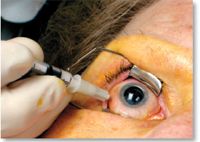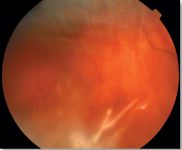Article
Intravitreal triamcinolone helps macular diseases
Montreal—Intravitreal triamcinolone acetonide (Kenalog, Bristol-Myers Squibb) is effective in the treatment of macular diseases but is associated with complications such as ocular hypertension, endophthalmitis, intraocular inflammation, and progression of cataract. While the long-term effects of the drug still need to be determined, the drug appears to be safe for treating macular diseases.

Daniel B. Roth, MD, and colleagues conducted a retrospective review of 1,000 consecutive eyes (839 patients, 56% women) treated with intravitreal triamcinolone from June 2001 to June 2004. The median age of the patients was 71 years . Four hundred twenty-four eyes were pseudophakic; 449 had undergone a previous laser treatment. The median follow-up time was 13.3 months. Dr. Roth presented the study results at the American Society of Retina Specialists annual meeting in Montreal.

"The complications associated with intravitreal triamcinolone can be divided into four subgroups: ocular hypertension, cataract progression, endophthalmitis, and others," said Dr. Roth, who is affiliated with the Retina Vitreous Center in New Brunswick, NJ and an assistant professor at Robert Wood Johnson Medical School.

Of 576 phakic eyes in the study, progression of cataract developed in 41% of eyes followed for more than 1 year after injection. Only 19% underwent cataract extraction during the course of the study.
Sterile endophthalmitis, which was defined as hypopyon and obfuscation of fundus details, developed in six eyes; marked inflammation with visualization of the fundus details and no hypopyon developed in four eyes. One eye had anterior scleritis at the site of injection of triamcinolone; three eyes had a corneal abrasion from betadine; one eye with a scleral buckle had a recurrent retinal detachment; and one eye experienced a central retinal vein occlusion associated with a moderate IOP elevation following injection of triamcinolone, Dr. Roth reported.
In 10 eyes with inflammation, seven eyes had undergone injection of triamcinolone for treatment of postoperative CME; however, only 11.7% of the total series had undergone injection of triamcinolone for that indication, Dr. Roth pointed out. Six of the eyes with inflammation had had a previous vitrectomy. Eighty percent of the eyes with inflammation developed ocular hypertension, and four of the eyes had received intraocular antibiotics without vitrectomy, but none was culture positive.
"This may suggest the hyperinflammatory state in postoperative CME," he emphasized.
Newsletter
Don’t miss out—get Ophthalmology Times updates on the latest clinical advancements and expert interviews, straight to your inbox.





